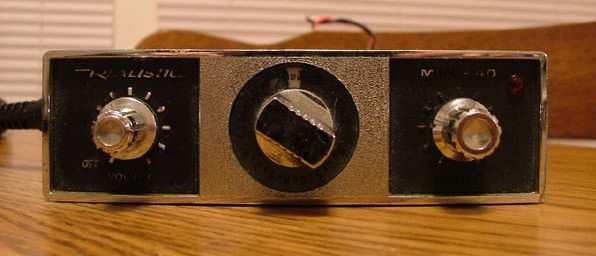

This is the Realistic Mini-40. A super small (By the standards of the day) no-frills 1st generation 40 channel radio, designed to be mounted in vehicles which lacked sufficient space for larger radios. This radio debuted in 1977 and continued in the footsteps of earlier R.S. Mini 23 channel versions, although they shared nothing other than physical appearance. As a "no frills" radio, features are sparse, consisting of little more than a Volume, Squelch, Channel selector and a Modulation indicator. Like many other 1st generation radios, this one sported a back-lighted numeric channel dial, with small, hard to read numbers. Newer designs (like the TRC-479) managed to get even smaller while also incorporating a much easier to read LED channel display.
Performance wise, this radio could hold it's own with many larger radios. The transmitter had strong audio and could be peaked up to about 5 watts before modulation % started falling off. The receiver had decent sensitivity and about average adjacent channel rejection. The built-in "always on" noise limiters were fairly effective at noise reduction. The Phase Locked Loop (PLL) circuit was not quite as modification friendly as many other 1st generation 40 channel radios. This radio was equipped with a Uniden upD861 PLL chip, which was the first attempt at a "custom CB PLL" which limited illegal channel capability. Curiously though, the chip had two modes, the "restricted" 40 channel-only mode, and an open 256 combination binary mode. Simply changing the mode would allow the usual channel expansion, although the channel selector did not match up in this mode. This led to the requirement for strange switching and an odd channel chart. But it could be done.
I obtained my Mini-40 in 1979, as a trade for my Tram XL5, and it needed a bit of work to bring it back into shape. Since I actually intended to press this radio into service for a while, I needed to make some modifications in order to bring it up to my standards of the time. My biggest beef with the radio was the lack of an "S" meter, so I added one and mounted it in a small plastic box which I affixed to the top of the radio. I also used the box as a place to mount PLL expansion switches. I then equipped it with a Turner +2 mike and mounted it in my current ride, which was short on suitable places to mount radios. I used it for 2 years before changing it out for one of my TRC-152's. I eventually sold the radio in 1984. On a scale of 1 to 10, I'd give this radio a 4. Like the children's story of the Little Engine That Could, this radio performed fairly well considering its size and the lack of features.